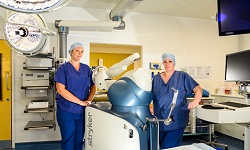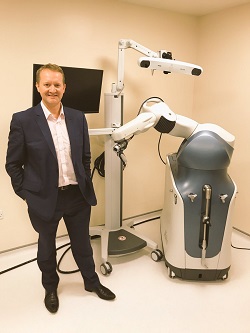Robotic Orthopaedic surgery – which robotic system do you choose?
You may have become aware of the launch of various robotic systems for orthopaedic surgery. Unless you have a degree in Engineering to understand the technological differences between each one, how do you, as a patient, choose the right one for you?
At Nuffield Health Leeds Hospital, for those opting for robotic assisted surgery for hip or knee replacement, our team uses the MAKO SmartRobotics TM system . Here are three reasons we opted for this robotic system for orthopaedic surgery.
1. The heritage.

MAKO SmartRobotics TM robotic system has been established for 15 years.
2. The research and technology.
There are over 250 published peer reviewed papers around the MAKO SmartRobotics TM systems clinical effectiveness with more papers published monthly. (Data on file: Stryker UK).
Stryker the company behind MAKO SmartRobotics TM have established over 1,000 patents around the MAKO system, to protect its leading technology.
3. The Numbers.
There have already been over 450,000 procedures using the MAKO SmartRobotics TM robotic-arm. It is now established and assisting orthopaedic surgeries daily in over 29 different countries.
In the UK the MAKO SmartRoboticsTM system is now widely adopted in both the NHS and private sector - with over 40 MAKO robots installed.
Nuffield Health Leeds Hospital was the first hospital in the North to adopt this leading and now very established technology.
What do our consultants say?
Our Consultant Orthopaedic Surgeon Mr Jon Conroy says:
“I’ve used the Mako robot for hip and knee surgery since 2017 here at Nuffield Health Leeds Hospital. I was first introduced to Robotics in the USA in 2013: thanks to my engineering experience I was asked to join the design team for the hip implant that’s currently used for Mako robotic surgery. My Master's in Mechanical Engineering has given me an interest in the technology and being involved in the introduction of robotics in the USA gave me a head start in the UK.
Despite reservations from many surgeons and other hospital groups, Nuffield Health Leeds Hospital was an early adopter of the technology and has established itself as the market leader in Orthopaedic Robotics.
The Mako system is well established across the globe and now in the UK. It’s the only system I’m aware of that performs total hip replacement, total knee replacement, uni-compartment knee replacement and patello-femoral replacements.
I personally perform all of these procedures through Nuffield Health Leeds Hospital and have gained experience of more than 750 cases. I teach and certify Consultant surgeons in the UK, across Europe, China, Japan and Taiwan.
The entry of new robotic systems on the market have made it important for the patient and surgeon to question a robotic system’s credentials. It is important the patient and surgeon review the potential benefits and risks of a new system compared to the established Mako system.
Important considerations that made me choose MAKO include:

- A well proven established and safe system.
- Widely adopted across the globe and within the UK.
- Ability to perform total hip replacements, knee replacements and uni-compartment knee replacements with published good outcomes.
- 3D CT pre-operative planning to ensure the correct size of implant is used and enables pre-operative virtual surgery.
- Accurate soft tissue balancing to ensure a correctly balanced joint.
- Haptic technology of the cutting blade, directly making multiple cuts and burring of curved surfaces. Mako allows direct bone cuts with minimal damage to soft tissues as the system will switch off as soon as it completes the bone cut.
After my own experience performing hundreds of robotic replacements over five years my preference is with the MAKO robotic system.”
What do our patients say?
Bill's Story
Bill was one of our first patients who had Mako robot-assisted hip replacement surgery at Nuffield Health Leeds Hospital in 2017.
Book an appointment to find out more.
Learn more about Robotic Orthopaedics at Nuffield Health Leeds Hospital
To book a consultation with an orthopaedic surgeon who specialises in using the Mako robotic-arm for hip or knee surgery call: 0113 388 2067.
Figures source: Data on file Stryker UK



